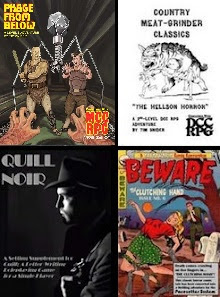The 30-year-old fantasy card game from my youth is Mayfair's Encounters.
The game is played with two decks of cards (Hero and Monsters/Magic) and a pair of dice. Each player draws seven cards at random from the Hero deck and places them into two lines of defense. The Heroes can be Elves, Dwarves, Knights, Wizards, Clerics, Men-At-Arms, and Paladins, and each has a specific Ability Score depending on their strength.
The players then draw seven cards from the Monster/Magic deck for their hand.The Monster/Magic deck contains Wizard and Cleric scrolls (usable only by the appropriate class), weapons and magic items (again, usable only by specific classes, but can also be banked as treasure), and treasure (for banking as..you know...treasure). The remainder of the deck consists of a selection of fantasy monsters like Giants, Demons, Vampires, and -- of course -- Dragons.
Combat is resolved by each player rolling one die for his Hero/Monster, then adding the Ability Score on the card (as well as any modifiers bestowed by granted weapons). High roll wins, with ties going to the defender. Monsters can only attack the front line unless they have the flying ability (letting them swoop down upon weaker Heroes in the rear ranks). Before combat, Wizards can cast spells (if a scroll is held); Clerics can try to turn undead; Elves can fire bows at any attacker even if they're not targeted; etc. Meanwhile, the attacker can send Dragonfire down upon the defender; have a Demon's curse placed upon the Heroes; and even summon the specter of Death himself to vanquish a particularly troublesome foe.
Once all players but one have all of their Heroes destroyed, the players add up their banked treasure. The player who had heroes remaining is given a 1,500 gp bonus. High GP value wins. My brother and I would instead play "Last Man Standing" where we'd attack each other until there was a victor. (We didn't really bank treasure when we played.) As you can see, the game is incredibly simple, but there's a bit of strategy involved as you organize your lines of defense and arm your party for the onslaught. It's a great little game -- a fun beer-and-pretzels diversion. Apparently there was a later CCG version of the game, but the original version will always have a place in my heart -- and now, a place on my game shelf.



















































































No comments:
Post a Comment